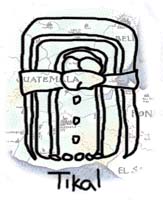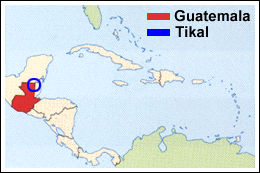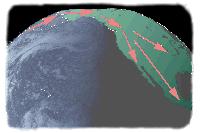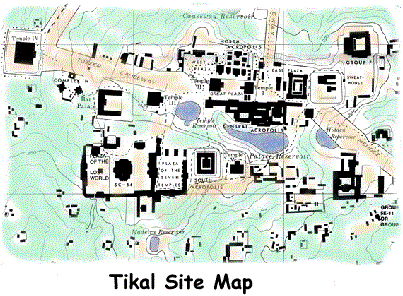
|
"It lay before us like a shattered bark in the midst of the ocean, her masts gone, her name effaced, her crew perished, and none to tell whence she came, to whom she belonged, how long on her voyage, or what caused her destruction."
|
John Lloyd Stephens, 1842
|
Tikal
Introduction
It is impossible to take the quarter of a mile walk through the lowland tropical rainforest that spills you into the middle of the Central Plaza of Tikal without understanding the 150-year-old awe of John Lloyd Stephens at his first site of a Mayan ruin. The mute imperial glory of the temples, the majesty of giant mahoganies, all combine to an effect that's almost magical - pyramids in the middle of a rainforest. And like all humans, standing in the middle of the Plaza or on top of a temple is not enough, we must understand all - the people, their gods, what drove them to create this place.
A century and a half of study has not yielded all the answers but, as the following thumbnail sketch shows, we've made it into the foyer of the house of knowledge.
Where is it?
Tikal is to be found in the North Eastern area of Guatemala in Central Americal. To the north lies Mexico and to the west is Belize.

The Basics
 Sometime between 12,000 and 20,000 years
ago primitive hunter gatherers crossed the frozen
Bering Strait into the Americas. By the first millennium b.c. a complex culture
called the
Olmec had arisen in the valley of Mexico, building
impressive cities and carving two ton basalt heads. Around 600
b.c. some of these people found their way to the Peten jungle
of lowland Guatemala where they began what would be over 1100
years of ceaseless construction on the site we know as Tikal -
a traditional name whose meaning is lost to us.
Sometime between 12,000 and 20,000 years
ago primitive hunter gatherers crossed the frozen
Bering Strait into the Americas. By the first millennium b.c. a complex culture
called the
Olmec had arisen in the valley of Mexico, building
impressive cities and carving two ton basalt heads. Around 600
b.c. some of these people found their way to the Peten jungle
of lowland Guatemala where they began what would be over 1100
years of ceaseless construction on the site we know as Tikal -
a traditional name whose meaning is lost to us.
During the classic period, from 250
to 550 a.d., Tikal was home to more than 150,000 people and covered
over 20 square miles. Sometime in the ninth century, fo what is
now believed to be a combination of cultural and environmental
reasons, the city was abandoned to the jungle - the last date
carved into the monuments was 869 a.d.
Although locals probably always knew
of the ruins, Tikal was not officially "rediscovered"
until 1848 when an expedition was made to the site by members
of the Peten government. They found temples, palaces, and pyramids
covered with a thousand years worth of tropical growth - 200 foot
temples were capped with 175 foot trees. In the twentieth century
mammoth excavations and reconstruction's have been undertaken
through a collaborative effort between the Guatemalan government
and several U.S. universities. Still, only a small amount of the
metropolis has been released from its living tomb.
In the last twenty years dramatic breakthroughs
in decoding the rotund and sometimes menacing
Mayan hieroglyphs have delivered to us from the previously
mute monuments a culture of kings and queens and priests and blood, of ritulised warfare
and enemy city-states, of massive construction and mass desertion,
of complex astronomical as well as mathematical knowledge - in
short, one of the most advanced civilisations of the ancient world,
Old or New.
The abandonment of Tikal and other classic
Mayan cities at the end of the first millennium is still not completely
understood - the most highly regarded theories blame a combination
of factors including environmental destruction, underclass rebellion,
famine, and theocratic doomsaying. And, contrary to a dimestore
para-science rumor, the Maya did not disappear, they migrated
west to the highlands where, after five centuries of Spanish rule,
they still weave their own clothing and practice the ancient rituals.
This year after a truce ended a brutal
civil war that, in the last 15 years alone, claimed over 100,000
Maya wither killed or "disappeared" there is, at last,
peace. Out of this peace has blossomed a "Mayan renaissance."
The surviving 21 tribes (over 60 percent of the Guatemalan population)
with their separate cultures and languages are being allowed,
for the first time since the Conquistadors, to take a proportionate
amount of involvement in their government and education. (See
NY Times Aug. 12, 1996)
And while the living embark on a round
to long-sought independence, each day more is decoded, unearthed,
and understood about the magnificent and magical city of the jungle.
Ruins Map
|
The Tikal National Park spans 222 square
miles across northeastern Guatemala. Approximately 20 square miles
of ruins have been mapped. From atop any of the taller structures
you can see in almost all directions tree-covered hillocks - these
are unexcavated ruins.
|

Pith & Particulars
- the Maya created books from bark paper in which
to record astronomical and historical data - these books are called
codices - as of yet only five are known to exist - most were burnes
by the Spanish priests after conquest - four of these books make
their homes in European cities.
- the Maya have a complex calendrical
system (it is still observed today among most Maya)
- two recurring cycles of time (a
260-day cycle and a solar year of 365 days) run simultaneously
- the 260-day cycle is a ritual almanac
consisting of 20 named days (the names were those of gods) and
13 numbered days with the exact combination of number and name
repeating every 260 days - birth dates are interpreted and significant
cultural events are planned to be held on days that bode well
- time and religion are inseparable.
- the solar calendar is made up of
18 months of 20 days with five additional days of apprehension
and bad luck at the end of the year.
- together they make up a period of
52 years (how long it takes for a day - name, number, solar day
- to repeat itself) it is called the Calendar Round.
- the calendar Round is part of a
system to measure the far past and the future called the Long
count - time is related to a fixed starting point corresponding
to August 13, 3114 b.c. (the significance of this date is unknown
but believed to be of mythological importance).
- dates are organised into groups
of 20 days as follows: baktun (144,000 days or 20 kaktuns); katun
(7,200 days or 20 tuns); tun (360 days or 18 uninals); uninal
(20 days or kins); kin (one day) - a date, written 9.12.7.0.9
reads left to right - 9 baktuns, 12 katuns, 7 tuns, 0 uninals
and 9 kins - it is calculated from the beginning of time.
- the most important structures were
aligned to astronomical events including the vernal and autumnal
equinox, the summer solstice, or the slignment of planets.
- the Maya tracked and predicted the
movement of Mars, Venus, Mercury and Jupiter
- the Maya were employing a symbol
for zero by, at least, the first century b.c.
- the temples at Tikal, which are
white today, were originally painted a fiesta of red, blue, green,
yellow, orange.. you name it, if there was a dye available, it
went on the walls.
- the Maya employed no metal tools
in all their buildings and carving - they used obsidian and jade
to cut and carve.
- there are 22 languages in modern
day Guatemala - one of them is Spanish, the rest are Mayan.
- the Maya Calendar ends, ominously,
December 23, 2012.
Natural Phenomena
Critters
In the deciduous tropical rainforest
that has overcome the massive monuments there's a lot of criters
lurking. For instance :
- Tarantulas are
big and hairy spiders that can grow to a leg span of ten inches.
Females have survived up to 2 1/3 years without food and have
spanned lives over 20 years. Males seem to die quicker. Go figure.
The bite of both male and female is not particularly harmful to
humans although, ick, it should be avoided.
- Leaf Cutter Ants
march in large numbers to a tree, wearing a path into the jungle
floor sometimes inches deep. Each ant bites off a leaf section
several times its own body weight and carries it back to the nest,
sometimes as far as a mile away. At the nest the ants chew the
leaves and spit them out creating a compost where mushrooms grow.
The ants harvest the mushrooms and feed the colony. If the leaves
are too dry the ants put them outside the nest overnight to gather
moisture, if they are too moist they leave them out during the
day. If the leaves get soaked, they throw them out and start over.
These insects are farmers.
- Crawling through the trees, more
cat-like than swinging ape, the black howler monkey, hanging
out in groups usually no larger than ten, marks a territory with
his howl - a roar part primate, part lion, that can be heard up
to 3 km away. Helpful hint: Don't hang out underneath,
they enjoy soiling the tourists.
- Over 200 species of birds
fly about providing some of the best birding in the world.
Vegetable Matter
Among the majestic mahoganies and cedars,
many over 200 feet tall, stands the giant, sacred ceiba
which, according to the Mayan cosmic view stands at the earth's
center uniting the universe. It's roots reach into the forbidding
Underworld and it's trunk stretches up from the heart into the
heavens.
Must Do It
-
Temple IV, at 230 feet, affords the most spectacular
view of the other temples standing quiet sentinels as they jut
out above the forest. Tree-covered hillocks nearby bear evidence
of unexcavated ruins. Sunset everyday is amazing of course, but,
if at all possible, visit on the full moon which rises as the
sun sets. Sitting atop the temple, with the moon rising, the sun
setting, monkeys howling, and toucans flying past, "almost
magical" seems an understatement.
-
Arrive at Temple III in the dark
before daybreak - sit, listen, and watch the jungle come alive
and the sun rise over the Central Plaza.
|
Author : Scott Cardwell, (c) 1996
|